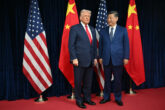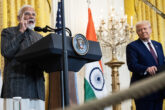February 07, 2023
Atomic Strait: How China’s Nuclear Buildup Shapes Security Dynamics with Taiwan and the United States
Executive Summary
This report examines the intersection of China’s nuclear modernization and cross-Strait tensions, especially how they might play out during a crisis, contingency, or conflict involving China, Taiwan, and the United States. Beijing is rapidly modernizing its nuclear arsenal to make it larger and more sophisticated. Changes include an increase in warhead numbers from more than 400 today to potentially 700 by 2027 and more beyond, consolidating a nuclear triad, developing new delivery systems, and digging at least 300 new missile silos. Some factors still could constrain the growth of China’s arsenal or the policies that shape the way Chinese leaders employ it. They range from fissile material stocks to competing military spending priorities, considerations about China’s international reputation, and upholding Beijing’s claimed No First Use policy. But nearly all those constraining factors either already have weakened or could do so in the near future.
China’s expanding nuclear arsenal suggests that the force will be designed to fulfill new missions. Some part of Beijing’s buildup surely is meant to bolster its second-strike retaliatory capability in the face of what China perceives as shifts in U.S. conventional and nuclear capabilities and policies. China’s long-term goal for the expansion, however, could be more ambitious and potentially even include seeking to build an arsenal on par with Washington’s and Moscow’s. Meanwhile, China continues to ramp up pressure on Taiwan using political, economic, and military tools. Beijing’s campaign could provoke more crises in the coming years. The three major roles that nuclear weapons could play for China when dealing with cross-Strait crises or conflicts are: to shield China from U.S. nuclear coercion, to threaten Chinese nuclear use to try to forestall U.S. intervention, and to conduct a limited Chinese nuclear detonation in an attempt to force U.S. and Taiwanese capitulation.
The report concludes with recommendations for U.S. policymakers. It calls for carrying out U.S. nuclear modernization plans to deter China but avoiding nuclear arms racing as a strategy in itself. It recommends incorporating nuclear elements into contingency planning and scenario exercises related to Taiwan, both unilaterally and with allies and partners. The report then calls for improving Taiwan’s conventional military capabilities while maintaining a consistent U.S. policy on cross-Strait issues and ensuring Taiwan forgoes pursuing indigenous nuclear weapons. Finally, the report argues in favor of pushing forward tough-minded bilateral engagement with Beijing on strategic stability and security issues while crafting a multilateral arms control strategy that builds coalitions to incentivize China to join and impose costs on Beijing if it opts to stay outside of key agreements.
Introduction
In his September 2022 address to the United Nations General Assembly in New York, U.S. President Joe Biden highlighted two major trends related to the People’s Republic of China (PRC).1 The first trend was growing tensions across the Taiwan Strait. The second trend was the rapid modernization of Beijing’s nuclear arsenal, operated by China’s military, the People’s Liberation Army (PLA). Biden’s remarks captured deepening concerns in Washington and beyond about those two trends and how they might interact. Russia’s implicit threats to use nuclear weapons in Ukraine only have added to trepidations about whether China might do the same against Taiwan.
This report examines the intersection of China’s nuclear modernization and cross-Strait tensions, especially how they might play out in the case of a crisis or contingency involving China, Taiwan, and the United States.2 It proceeds in six sections. The first takes stock of how China is modernizing its nuclear arsenal to make it larger and more sophisticated. Second, the report considers constraints on China’s nuclear arsenal and how they might be weakening. The third section looks at how the military purposes for Beijing’s nuclear arsenal might change as the force grows. The fourth section looks at China’s recent pressure campaign against Taiwan and the resulting tensions. Fifth, the report explores three potential roles that China’s nuclear weapons might play in cross-Strait contingencies. The sixth and final section provides recommendations for U.S. policymakers in the executive and legislative branches.
Download the Full Report
- Joe Biden, “Remarks by President Biden Before the 77th Session of the United Nations General Assembly” (September 21, 2022, U.N. Headquarters, New York), https://www.whitehouse.gov/briefing-room/speeches-remarks/2022/09/21/remarks-by-president-biden-before-the-77th-session-of-the-united-nations-general-assembly/. ↩
- Parts of the analysis in this report are adapted from: Jacob Stokes, “China’s Nuclear Buildup is About More Than Nukes,” Just Security, January 4, 2022, https://www.justsecurity.org/79622/chinas-nuclear-buildup-is-about-more-than-nukes/. ↩
More from CNAS
-
Indo-Pacific Security / Energy, Economics & Security
How to Win the Economic War with ChinaTrump's approach to China has run aground, giving Beijing unprecedented advantage in the economic conflict....
By Edward Fishman & Julian Gewirtz
-
America’s Self-Loathing Is a Losing Hand
This article was originally published in The Washington Post.Around 10 years ago, the United States began a historic shift in its grand strategy toward China, abandoning the b...
By David Feith
-
Indo-Pacific Security / Energy, Economics & Security / Technology & National Security
Selling AI Chips Won’t Keep China Hooked on U.S. TechnologyU.S. policy should not rest on the illusion that selling chips can trap China inside the American tech ecosystem....
By Janet Egan
-
Will New Delhi-Beijing Move Beyond Friction Points? | Ex-White Official On India-China Reset
Prime Minister Narendra Modi on Friday said that India and China, as two major economies, must work together to bring stability to the global economic order. NDTV's Gaurie Dwi...
By Lisa Curtis





